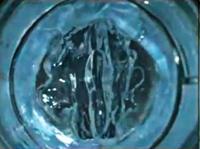New material could offer hope to those with no voice
By By Anne Trafton, MIT News Office | 14 Jul 2011
In 1997, the actress and singer Julie Andrews lost her singing voice following surgery to remove non-cancerous lesions from her vocal cords. She came to Steven Zeitels, a professor of laryngeal surgery at Harvard Medical School, for help.
 |
| Researchers at MIT and MGH have developed a polymer gel that mimics the vibrations of human vocal cords. Image: MIT/MGH |
Zeitels was already starting to develop a new type of material that could be implanted into scarred vocal cords to restore their normal function.
In 2002, he enlisted the help of MIT's Robert Langer, the David H Koch Institute Professor in the department of chemical engineering, an expert in developing polymers for biomedical applications.
The team led by Langer and Zeitels has now developed a polymer gel that they hope to start testing in a small clinical trial next year.
The gel, which mimics key traits of human vocal cords, could help millions of people with voice disorders - not just singers such as Andrews and Steven Tyler, another patient of Zeitels'.
About 6 per cent of the US population has some kind of voice disorder, and the majority of those cases involve scarring of the vocal cords, says Sandeep Karajanagi, a former MIT researcher who developed the gel while working as a postdoc in the Langer Lab.






























